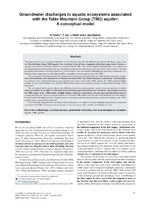| dc.contributor.author | Roets, Wietsche | |
| dc.contributor.author | Xu, Yongxin | |
| dc.contributor.author | Raitt, Lincoln | |
| dc.contributor.author | Brendonck, Luc | |
| dc.date.accessioned | 2013-11-15T08:28:30Z | |
| dc.date.available | 2013-11-15T08:28:30Z | |
| dc.date.issued | 2008 | |
| dc.identifier.citation | Roets, W., et al. (2008). Groundwater discharges to aquatic ecosystems associated with the Table Mountain Group (TMG) aquifer: a conceptual model. Water SA, 34(1): 77-88 | en_US |
| dc.identifier.issn | 0378-4738 | |
| dc.identifier.uri | http://hdl.handle.net/10566/821 | |
| dc.description.abstract | This paper reports on a conceptual model that was developed to describe the different groundwater discharge ‘types’ from
the Table Mountain Group (TMG) aquifer, that contributes to the different components of the flow regime in each of the recognised river reaches for streams and rivers associated with the TMG. This model integrates hydrogeological, ecological and
geomorphological understandings into an ecohydrological perspective linking ground- and surface water systems. Through
geospatial intersections of existing GIS layers a GIS model was also developed to highlight the quaternary catchments containing sensitive aquatic ecosystems that could be vulnerable to groundwater use from the TMG. The conceptual model demonstrates the intimate link between groundwater from the TMG aquifer and aquatic ecosystems in the mountain and foothill reaches of streams and rivers in the Cape Folded Mountains in particular. It also identifies
two primary zones of interaction between groundwater and surface water in the TMG, namely, the ‘TMG aquifer daylight-
domain’, located in the recharge zone, and the ‘TMG aquifer surface water interface-domain’, located at the discharge end of
the aquifer. The conceptual model clearly indicates the difference between real groundwater, and perceived groundwater contributions to streamflow in the TMG. It is the lower flows of the flow regime that will be most vulnerable to groundwater use from
the TMG aquifer in the ‘TMG aquifer daylight-domain’, which are unfortunately also the most important flows from an
ecological perspective. However, any groundwater use from the TMG aquifer will also affect the discharge end of the aquifer,
located far from the higher elevation recharge areas, or the point of groundwater abstraction, in lowland settings in the ‘TMG
aquifer surface water interface-domain’. The GIS model integrated the conceptual understanding into a management tool by highlight all quaternary catchments
associated with TMG containing sensitive aquatic ecosystems and gave the variable vulnerability for each. | en_US |
| dc.language.iso | en | en_US |
| dc.publisher | Water Research Commission | en_US |
| dc.rights | © 2008 Water Research Commission. This file may be freely used provided that the source is acknowledged. No commercial distribution of this text is permitted. | |
| dc.subject | Ecohydrology | en_US |
| dc.subject | Ecosystem dynamics | en_US |
| dc.subject | Groundwater abstraction | en_US |
| dc.subject | River basin management | en_US |
| dc.subject | Streamflow regime | en_US |
| dc.subject | TMG aquifer | en_US |
| dc.title | Groundwater discharges to aquatic ecosystems associated with the Table Mountain Group (TMG) aquifer: a conceptual model | en_US |
| dc.type | Article | en_US |
| dc.privacy.showsubmitter | false | |
| dc.status.ispeerreviewed | true | |
| dc.description.accreditation | Web of Science | en_US |

